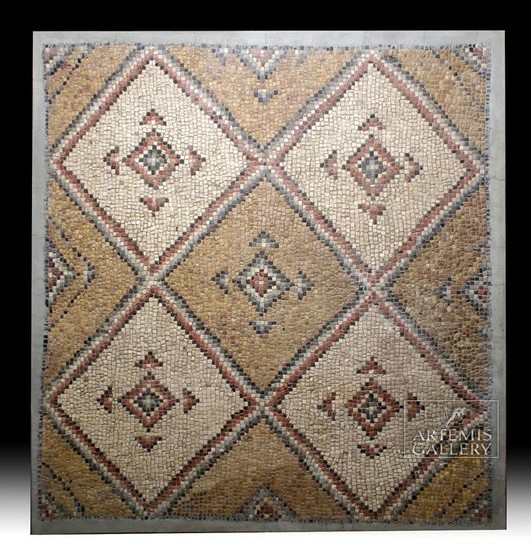Huge Roman Stone Mosaic Geometric Design
**Originally Listed At $8000**
Roman, the Levant, late Imperial Period, ca. 3rd to 5th century CE. A spectacular mosaic presenting an abstract quilt-like pattern of repeated diamond-shaped motifs - each form comprised of central nested diamond shapes with radiating arrowhead motifs from each side - these details in green, grey, white, orange, and peach hues against alternating golden yellow ochre and white backgrounds - all outlined by striated borders of forest green, sage green, white, russet, and olive green. A beautiful design in a warm color palette. Size: mosaic measures 42.75" W x 45.875" H (108.6 cm x 116.5 cm); 48" W x 48.375" H (121.9 cm x 122.9 cm) including plaster matrix and metal frame
Mosaics (opus tesellatum) are some of our most enduring images from the Roman world, exciting not only for their aesthetic beauty, but also because they reveal what Romans chose to depict and see every day decorating their private and public spaces. This example demonstrates the ancients' fascination with design as well as geometry.
In the Roman province of Syria, which encompassed most of the ancient Near East/Levant, mosaics developed as a common art form relatively late, with most finds coming from the 3rd century CE or later. Syria was one of Rome's wealthiest provinces, but it was also far removed from Rome itself and Roman culture was overlaid on enduring cultural traditions from Hellenistic Greece and the great civilizations that came before it. Antioch-on-the-Orontes (modern day Antakya, Turkey), was the capital of northern Roman Syria, and its excavations in the 1930s revealed more than three hundred mosaic pavements - of which many embellished public baths. Popular mosaic themes from this region were often mythological or religious scenes, depicting gods and goddesses; however, sometimes mosaics were simply created to fit the theme or design of a building or room.
Provenance: private East Coast, USA collection
All items legal to buy/sell under U.S. Statute covering cultural patrimony Code 2600, CHAPTER 14, and are guaranteed to be as described or your money back.
A Certificate of Authenticity will accompany all winning bids.
We ship worldwide to most countries and handle all shipping in-house for your convenience.
#139207
Condition Report: Expected surface wear with minor losses, nicks, fissures, recessions, and abrasions to tesserae commensurate with age. Set in a modern plaster matrix with a metal frame.
View it on
Estimate
Time, Location
Auction House
**Originally Listed At $8000**
Roman, the Levant, late Imperial Period, ca. 3rd to 5th century CE. A spectacular mosaic presenting an abstract quilt-like pattern of repeated diamond-shaped motifs - each form comprised of central nested diamond shapes with radiating arrowhead motifs from each side - these details in green, grey, white, orange, and peach hues against alternating golden yellow ochre and white backgrounds - all outlined by striated borders of forest green, sage green, white, russet, and olive green. A beautiful design in a warm color palette. Size: mosaic measures 42.75" W x 45.875" H (108.6 cm x 116.5 cm); 48" W x 48.375" H (121.9 cm x 122.9 cm) including plaster matrix and metal frame
Mosaics (opus tesellatum) are some of our most enduring images from the Roman world, exciting not only for their aesthetic beauty, but also because they reveal what Romans chose to depict and see every day decorating their private and public spaces. This example demonstrates the ancients' fascination with design as well as geometry.
In the Roman province of Syria, which encompassed most of the ancient Near East/Levant, mosaics developed as a common art form relatively late, with most finds coming from the 3rd century CE or later. Syria was one of Rome's wealthiest provinces, but it was also far removed from Rome itself and Roman culture was overlaid on enduring cultural traditions from Hellenistic Greece and the great civilizations that came before it. Antioch-on-the-Orontes (modern day Antakya, Turkey), was the capital of northern Roman Syria, and its excavations in the 1930s revealed more than three hundred mosaic pavements - of which many embellished public baths. Popular mosaic themes from this region were often mythological or religious scenes, depicting gods and goddesses; however, sometimes mosaics were simply created to fit the theme or design of a building or room.
Provenance: private East Coast, USA collection
All items legal to buy/sell under U.S. Statute covering cultural patrimony Code 2600, CHAPTER 14, and are guaranteed to be as described or your money back.
A Certificate of Authenticity will accompany all winning bids.
We ship worldwide to most countries and handle all shipping in-house for your convenience.
#139207
Condition Report: Expected surface wear with minor losses, nicks, fissures, recessions, and abrasions to tesserae commensurate with age. Set in a modern plaster matrix with a metal frame.



